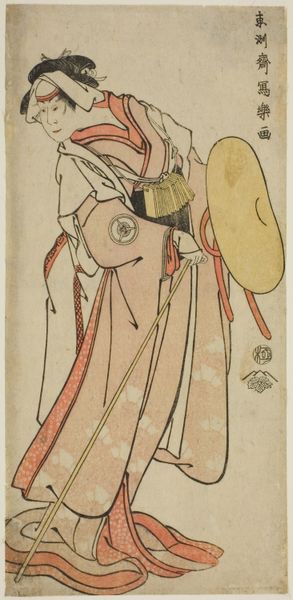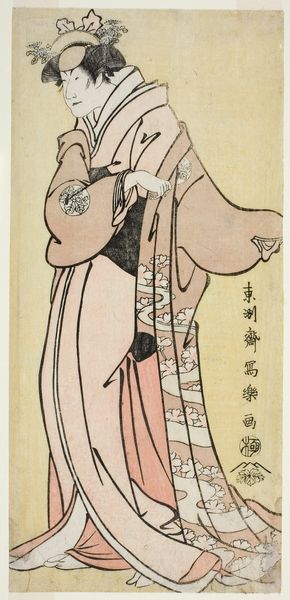
print, ink, woodblock-print
#
portrait
#
water colours
#
ink painting
# print
#
asian-art
#
ukiyo-e
#
figuration
#
ink
#
woodblock-print
#
line
#
watercolor
Dimensions: 28 1/4 × 4 in.
Copyright: Public Domain
Curator: Look at how Harunobu employs line in this print, The Heron Maiden. Its delicacy really sets a pensive mood, doesn't it? Editor: Indeed. I feel a strange stillness radiating from this ukiyo-e print. It is such a simple composition, and yet it invites introspection. Curator: Absolutely. Suzuki Harunobu made it around 1766 or 1767, a key period when multicolored woodblock printing, known as nishiki-e, became increasingly popular in Japan. Harunobu himself was instrumental in its development. Editor: Tell me more about nishiki-e and its socio-cultural importance? Curator: Certainly. Nishiki-e, meaning "brocade pictures", emerged as a response to growing demand for richer, more vibrant imagery amongst the rising merchant class in Edo. It signified not only artistic advancement but also shifting social dynamics, enabling broader audiences to access colorful art that was once reserved for the elite. These prints provided glimpses into contemporary life, theatre, and fashion, celebrating the vibrant culture of the time. Editor: I see how Harunobu captures ephemeral beauty through meticulous carving and printing; look at how each line and color interact. How would you read the composition of this artwork using its visual and technical vocabulary? Curator: Harunobu uses a limited palette of muted tones here, creating a subtle harmony. Note the elegant curvature of lines depicting the maiden's robes and the stylized umbrella above, which serve to frame the face while guiding the eye smoothly downward. I must add the expert use of negative space further accentuates the delicate quality of this woodblock print. The overall effect captures something profound about quiet beauty in Japanese culture at the time. Editor: It seems these beautiful figures and refined sensibilities quickly became symbols of social sophistication as they were replicated, collected, and circulated widely within the middle classes. Curator: That's precisely it. Now part of the collection here at the Art Institute of Chicago, The Heron Maiden offers insights into the complex interplay of aesthetics and culture that defined 18th-century Japan. Editor: The interplay between line and form is beautifully understated. Curator: It really draws the viewer in. This is just a small glimpse, but it is an enticing glimpse, into the world that Harunobu was showing to the art consumers of his time.
Comments
No comments
Be the first to comment and join the conversation on the ultimate creative platform.













